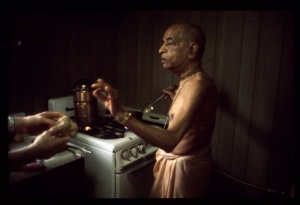CC Madhya 24.211 (1975)

A.C. Bhaktivedanta Swami Prabhupada
Below is the 1996 edition text, ready to be substituted with the 1975 one using the compile form.
TEXT 211
- ei ūniśa artha karilu, āge śuna āra
- ’ātma’-śabde ‘deha’ kahe,—cāri artha tāra
SYNONYMS
ei—these; ūniśa—nineteen; artha—meanings; karilu—I have done; āge—ahead; śuna—hear; āra—more; ātma-śabde—by the word ātma; deha—the body; kahe—is understood; cāri artha—four meanings; tāra—of that.
TRANSLATION
“I have already explained nineteen different meanings. Now please hear further meanings. The word ‘ātma’ also refers to the body, and this can be taken in four ways.
PURPORT
The four divisions of meanings of the word deha (“body”) are (1) aupādika-brahma-deha, the material body considered as Brahman with designations (vide verse 212), (2) karma-niṣṭha yājñikera karma-deha, the body engaged in ritualistic ceremonies of the Vedic injunctions (vide verse 214), (3) tapo-deha, the body engaged in austerities and penances (vide verse 216), and (4) sarva-kāma-deha, the body engaged for the satisfaction of all kinds of material desires (vide verse 218).